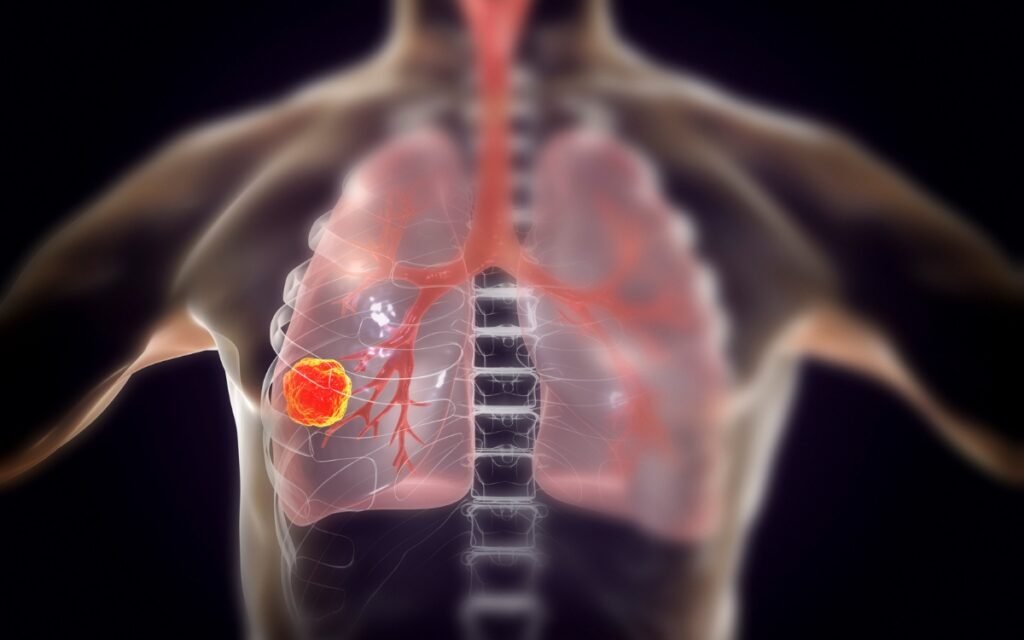ESMO 2023: LBA92
Most SCLC patients are diagnosed with cancer that has already spread beyond the lungs, and their average survival time is only slightly over one year. The recent use of PD-L1 inhibitors as part of the first treatment for SCLC patients was a significant advance, but the limited improvement in survival shows the urgent need for new ways to improve the treatment of this condition. Bispecific T-cell engager (BiTE) is a potential target for treatment development, as there are very few treatment options available for SCLC patients.
Several agents that target DLL3, a protein found on SCLC cells, are being tested in clinical trials and Tarlatamab is one of them. The drug is a bispecific T-cell engager (BiTE), which is a new type of immunotherapy for SCLC. It binds to both DLL3 on SCLC cells and CD3 on T cells, causing T cells to kill tumor cells.
A Phase I study showed promising safety and efficacy, with median duration of response (mDoR) of 12.3 months and median overall survival (mOS) of 13.2 months in previously treated SCLC. In the Phase II trial, the drug showed impressive anti-tumor activity with long-lasting responses and promising survival. The DeLLphi-301 trial, which could lead to approval, was designed to evaluate tarlatamab in SCLC patients who had failed two or more prior lines of treatment. The objective response rate (ORR) for patients treated with the 10-mg dose was 40% (97.5% CI, 29-52) vs 32% (97.5% CI, 21-44) with the 100-mg dose. The rate of patients who responded to tarlatamab for at least 6 months was 58% in the 10-mg group and 61% in the 100-mg group.
The difference in OS between arms grew over time. The 12-month OS rate was 87.6% in the pembrolizumab arm and 87.7% in the placebo arm. The 24-month OS rate was 79.0% and 74.7%, respectively. The 36-month OS rate was 71.3% and 64.0%, respectively. The 48-month OS rate was 67.1% and 51.5%, respectively.
The median EFS was 47.2 months in the pembrolizumab arm and 18.3 months in the placebo arm. The 12-month EFS rate was 73.8% in the pembrolizumab arm and 60.8% in the placebo arm. The 24-month EFS rate was 61.5% and 41.4%, respectively. The 36-month EFS rate was 54.3% and 35.4%, respectively. The 48-month EFS rate was 48.4% and 26.2%, respectively.
The most common side effect of treatment was cytokine release syndrome, which mostly happened in cycle 1 and was mostly mild or moderate. The rate of severe (grade ≥ 3) liver side effects was low, at 16% of patients. This is notable because, for LUMAKRAS (sotorasib), another KRAS inhibitor, the rate of severe liver side effects was higher, at 27% to 37%, when the KRAS inhibitor was given with or after a PD-L1 inhibitor.
These amazing results have inspired Mirati to plan the start of a Phase III trial comparing tarlatamab and pembrolizumab vs. pembrolizumab alone in treatment-naïve KRAS G12C patients. The Phase III KRYSTAL-7 trial plans to begin enrollment at the end of this year.
Tarlatamab is not just a drug, it’s a breakthrough in cancer treatment. It connects T cells and tumor cells and triggers tumor cell death. Tarlatamab is changing the game for SCLC patients with DLL3 mutation.
Conclusion
Small-cell lung cancer is a deadly type of lung cancer that affects ~15% of all lung cancer patients. Tarlatamab emerges as a promising therapy for previously treated SCLC patients, offering a potential breakthrough in the treatment landscape. While previous DLL3-targeted therapies had their limitations, newer options like BI 764532 and HPN328, with their innovative designs, show early signs of effectiveness in preclinical and clinical settings. These therapies collectively aim to enhance the treatment options available for SCLC patients.
The growing body of preclinical and clinical data underscores DLL3 as an exciting and promising target for addressing the unique challenges of SCLC. Tarlatamab’s early safety and effectiveness results stand as a significant milestone, reaffirming the potential of DLL3 as a viable therapeutic target and highlighting the promise of MHC-I bypass as an immunotherapy approach for SCLC. This progress reflects a positive direction in the ongoing quest to improve outcomes and quality of life for individuals battling this aggressive form of lung cancer.





























